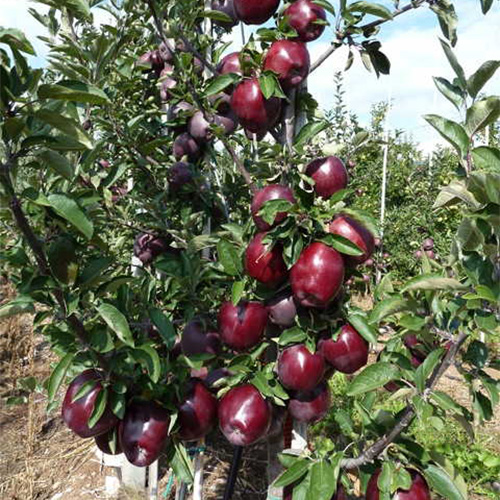
Jeromine Apple Tree
Origin: France
Description:The Jeromine Apple Tree is a modern variety distinguished by its exceptional winter hardiness and resilience to pests and diseases. It has a relatively upright growth pattern, which simplifies pruning and maintenance. The tree starts bearing fruit early in its life cycle and continues to produce reliably each year.
Fruit: The apples are medium-sized with a striking deep red color that almost covers a yellowish base. The flesh is white, firm, and juicy with a balanced sweet-tart flavor profile, making it excellent for fresh eating, salads, and baking.
Harvest: The Jeromine apple is typically ready for harvest from mid to late September, offering a reliable yield that is consistent year over year. The timing makes it an excellent option for extending the market availability of fresh apples.
Pollination: This variety benefits from cross-pollination with other apple varieties such as McIntosh, Empire, and Gala to ensure a high fruit set.
Spacing: Recommended spacing is about 3 to 4 meters between trees, which allows for optimal sunlight exposure and air circulation, crucial for healthy growth and fruit development. Mature trees can reach up to 4 meters in height.
Good to know: Jeromine Apple Trees are noted for their adaptability to various soil types and environmental conditions, making them a versatile choice for many orchards. They also have a lower susceptibility to common orchard diseases such as apple scab and mildew, which reduces the need for frequent chemical treatments.
ask prices
- We only sell bare root trees to countries in Europe. We can't export potted trees due to trade regulations.
- We can deliver the trees to all countries in Europe and some countries in Eurasia and Middle East. We can arrange a truck to deliver the trees to your country.
- We are a wholesale nursery. Our minimum order quantity is 3.000 trees. Please note that we don't take orders below this limit.
- Phytosanitary certificates are provided with all orders. These certificates prove the origin of the trees and certify that they are free of diseases.
MM 9 (Dwarf)
M 9 is a dwarf rootstock suitable for high-density planting. It is resistant to the crown rot disease and moderately sensitive to the fire blight and wooly aphid. It is resistant to the illness of the tree tree and mildly susceptible to the blight of flames and wooly aphid. Throughout cultivation, it requires support systems. It should not be grafted on spur-type varieties such as Scarlett Spur, Redchief and Starkspur Golden. For the field, it should be recommended without limiting watering. It is moderately resistant to calcareous and heavy-textured soils. High crop quality, early fruit bearing and elevated efficiency out of a unit region within a brief span of moment are the most advantageous features M 9 offers to the plants.
MM 106 (Middle size)
It is a semi-dwarf rootstock, resistant to wooly aphid and is highly sensitive to disease of crown rot. For heavy-textured and argillaceous soils, it should certainly not be suggested. It has a closer and heavier root structure than rootstocks M9 and M26. Although it is more resistant to the climate than rootstocks M9 and MM 26, it should be chosen for frequent watering plants.For the gardens where MM 106 is grown, support devices are not needed. Within three or four years after planting, it becomes commercially profitable.
MM 111 (Large)
It is a semi-dwarf rootstock bigger than M106 and smaller than standard seedling rootstock. It is resistant to the illness of crown rot, wooly aphid and heavy-textured, argillaceous, calcareous plants with a pH scale above 7. Depending on the circumstances of care, it becomes commercially profitable within four or five years. When early flowering is desired, M 9 may be recommended as the rootstock between the system in some cases. When grafted on spur form and low strength varieties, it provides stronger outcomes.






